Dichorisandra thyrsiflora
With some species, the blooms are the focal point. And with others, the glossy green leaves take center stage.
It’s nice when ornamental plants can offer both floral interest and bold foliage in equal parts – and blue ginger is one such plant.
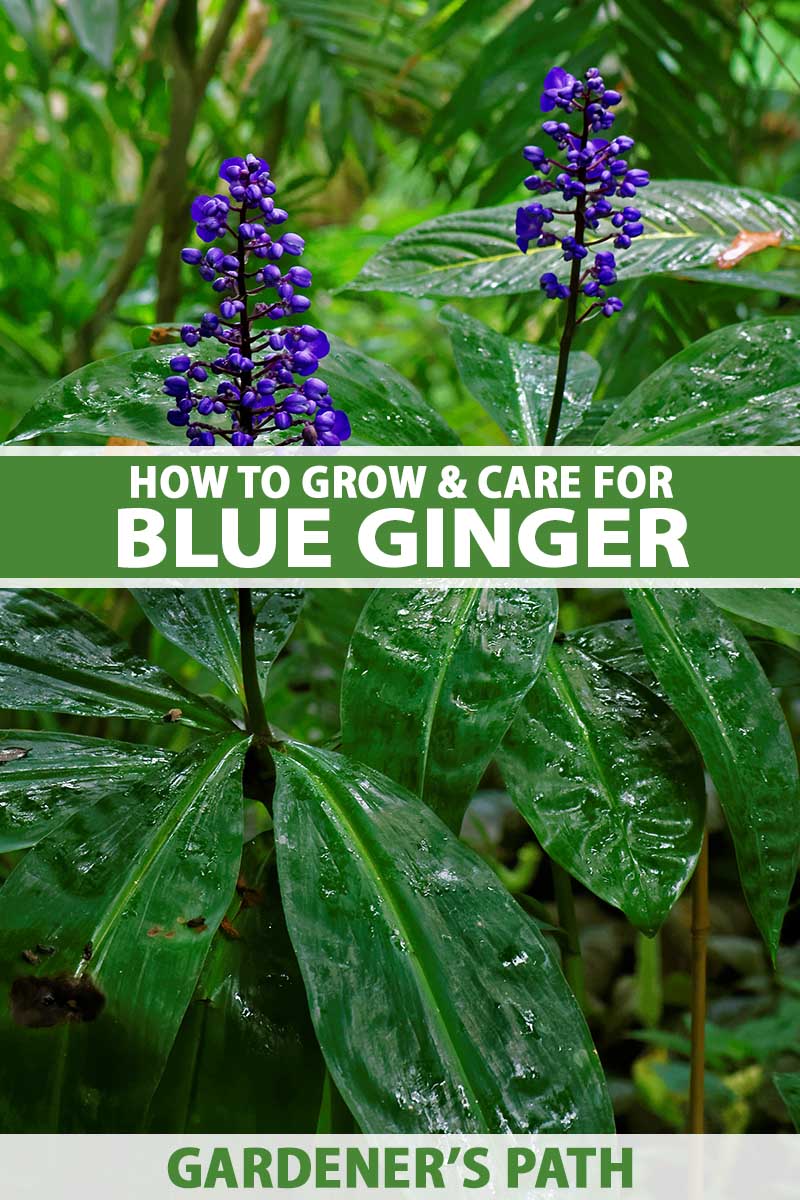
We link to vendors to help you find relevant products. If you buy from one of our links, we may earn a commission.
Dichorisandra thyrsiflora flaunts its violet blue flowers and deep green foliage like an ambidextrous samurai wielding twin katanas… or maybe a Scottish Highlander brandishing two claymores… or a Ghilman with dual scimitars, perhaps.
The point being: just like a blade, blue ginger looks pretty sharp.
This plant grows quickly, is easy to care for, and is surprisingly tolerant of certain less-than-ideal conditions.
Plus, the vibrant color of its flowers makes it a botanical rarity, since less than 10 percent of all flowering flora have blue blooms.
Learning how to care for D. thyrsiflora is as simple as picking up some basic know-how and giving it a try. With this guide, we’ll provide the tips and tricks. Hopefully it’ll inspire you to do the rest!
Here’s everything we’ll be going over:
What You’ll Learn
What Is Blue Ginger?
To begin, Dichorisandra thyrsiflora shares the common name “blue ginger” with Alpinia galanga, also known as galangal.
Though these plants share a resemblance, to some degree, in terms of growth habit and form, they are unrelated.
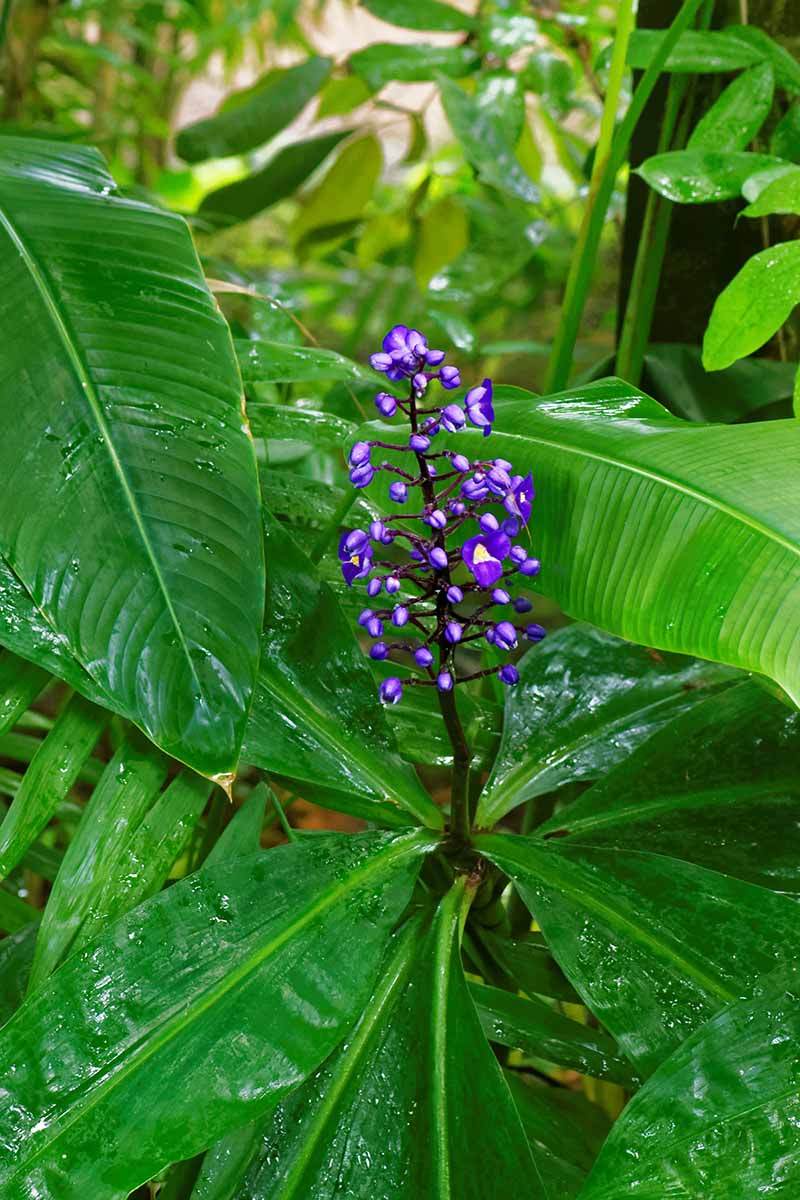
D. thyrsiflora is not a member of the ginger or Zingiberaceae family, nor is it edible. It is actually part of the Commelinaceae family, alongside various species of dayflowers and spiderworts.
Native to southeastern Brazil and best cultivated in USDA Hardiness Zones 9 to 12, blue ginger produces violet blue flowers in clusters up to eight inches long, with each individual blossom being up to three-quarters of an inch wide.
The flowers are fertilized via buzz pollination, i.e. when bees land on flowers and rapidly vibrate their thoraxes, coaxing the release of pollen. When pollinated, these flowers eventually produce seeds within striking orange berries.
Underneath these striking blooms are glossy, lance-shaped, deep green leaves that grow up to a foot long and two inches wide.
The leaves emerge with sheathed bases in a fashion similar to red ficus, and are alternately arranged in a spiral around the cane-like stems, almost like a staircase.
As clump-forming plants, individual blue ginger specimens use their rhizomatous root systems to establish colonies, which can lead to pretty substantial masses of D. thyrsiflora in time.
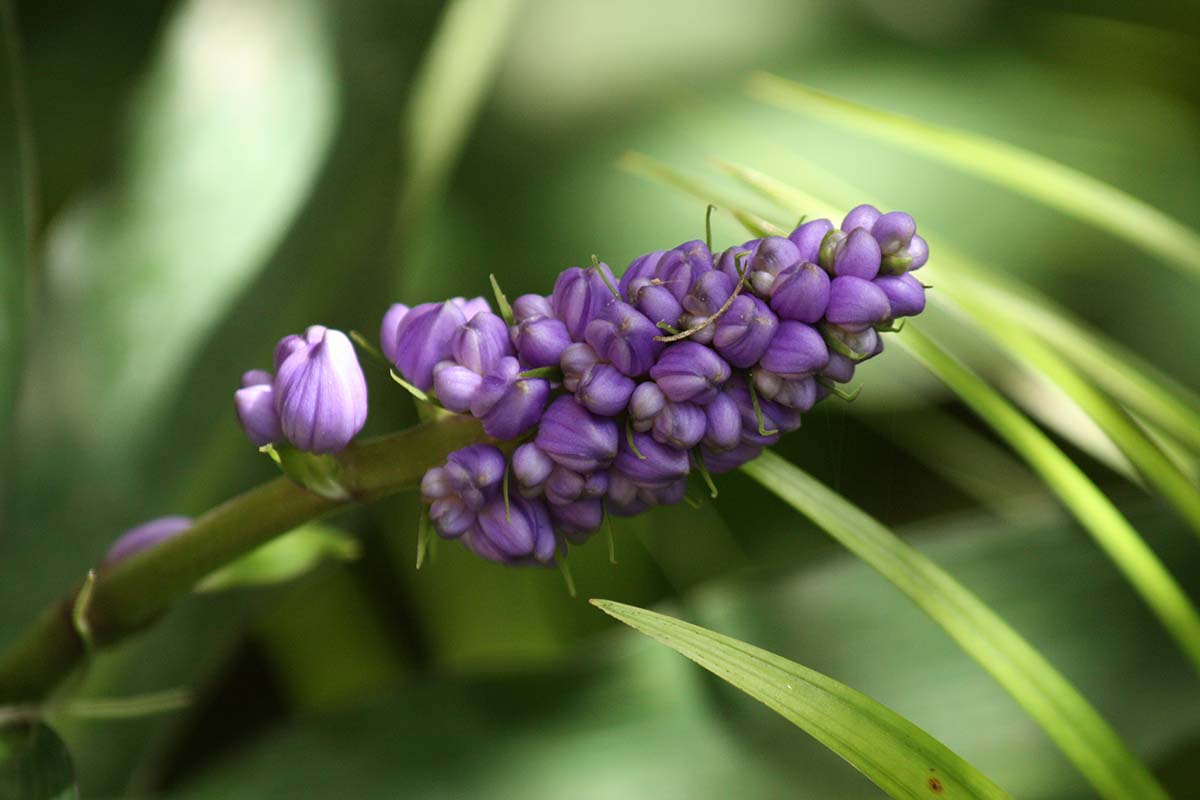
When discussing blue ginger, it’s important to differentiate D. thyrsiflora from its close relative D. pendula, aka weeping blue ginger.
The difference is right there in the name: standard blue ginger grows pretty upright, whereas weeping blue ginger develops a cascading habit with maturity.
Additionally, D. thyrsiflora blossoms over a six- to eight-week-long period in the summer and fall, while D. pendula blooms sporadically year-round.
Cultivation and History
To understand blue ginger’s horticultural origin story, we need to wind the clock back to the Austrian expedition to Brazil, financed by the Austrian Empire, which took place from 1817 to 1835.
Fourteen experienced naturalists were recruited for the expedition, including Johann Christian Mikan, a natural history professor at the University of Prague and an accomplished botanist.
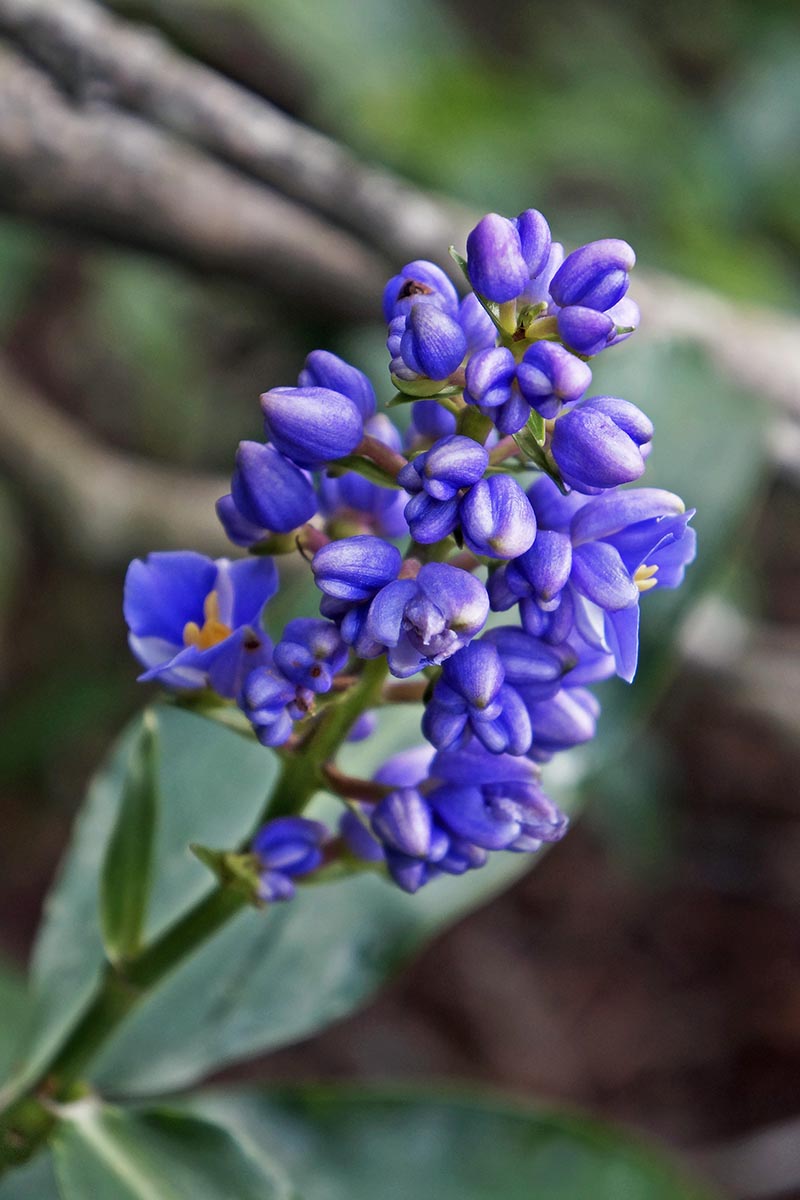
As the expedition team worked its way through Brazil, Professor Mikan happened upon and described D. thyrsiflora for the first time.
The genus name Dichorisandra alludes to the double anthers of the flowers, while thyrsiflora references the way the blooms grow on staff-like stems.
In 1822, a blue ginger specimen grown in the United Kingdom was documented by Sir William Macarthur in his catalogue Hortus Camdenesis. Its popularity in cultivation continued to grow and spread in the subsequent centuries.
Later, D. thyrsiflora earned the coveted Award of Garden Merit from the Royal Horticultural Society in 2012. Across the pond in the United States, blue ginger was selected as Plant of the Year by the Florida Nursery Growers and Landscape Association in 2008.
To this day, D. thyrsiflora remains a beloved addition to residential and commercial gardens, both indoors and out.
Propagation
You have a handful of options for propagating blue ginger: planting dormant rhizomes, rooting stem cuttings, division, or transplanting.
From Rhizomes
Planting dormant rhizomes is a pretty simple process, whether in the ground or in a container.
After soaking the rhizomes in water for a few hours, bury them an inch or two deep in the soil or potting mix positioned horizontally, with any nodes pointing upwards.
Rhizomes can be planted in individual pots, or spaced about 18 to 36 inches apart in the garden.
Water in to settle, and and keep the soil moist as new growth emerges and matures.
From Stem Cuttings
To harvest cuttings from a mature plant, select the healthiest-looking stems in spring or summer. With a sterilized blade, cut directly below a node.
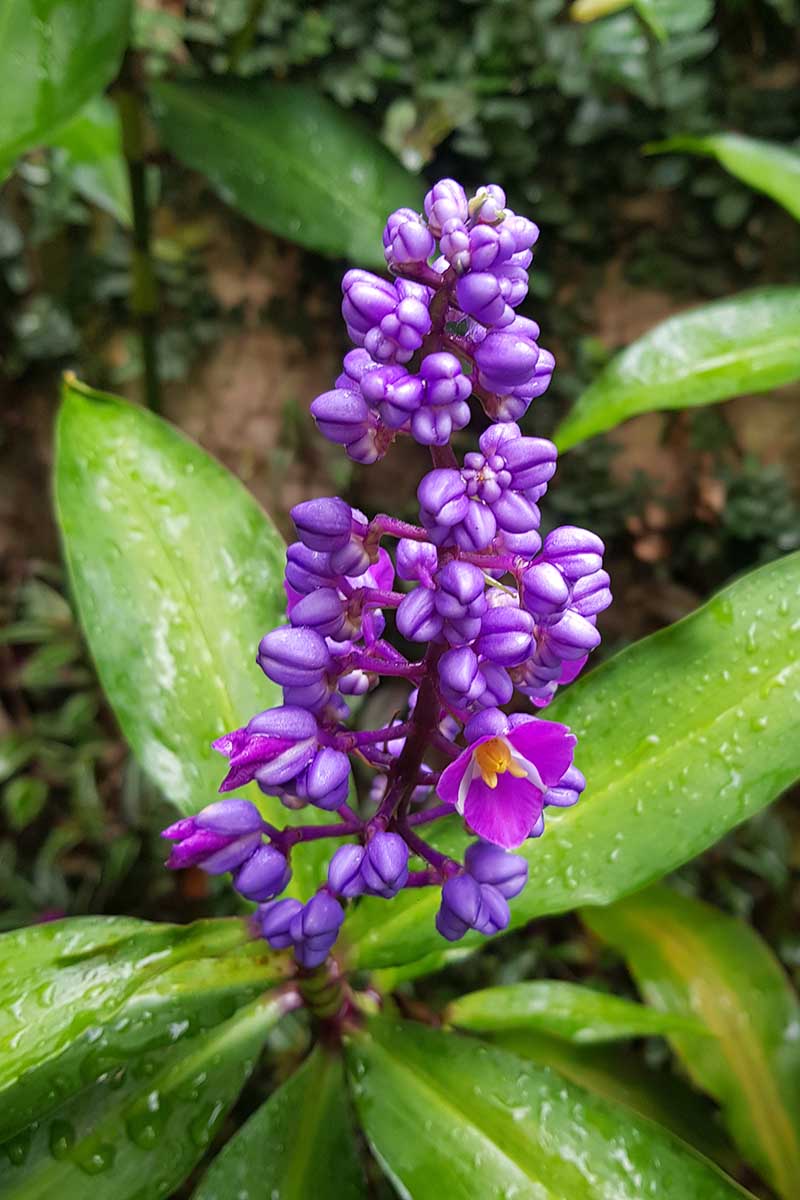
Make sure each cutting is at least four inches in length, and that each one bears three to six leaves.
Defoliate the bottom half of each cutting, then submerge it by half in water to encourage root development.
The containers that you choose for this can be anything, really. Mason jars, test tubes, even tall double shot glasses – whatever you have on hand.
Place the containers in a bright, indirectly lit area indoors.
Once their newly-formed roots exceed two inches in length, the cuttings are ready to go into three-inch pots filled with a 50-50 mix of sphagnum peat moss and perlite.
Make sure the pots have drainage holes! Bury the roots while keeping the foliage above the soil line and water them in.
Choose a location where the rooted cuttings will receive bright, indirect light somewhere in your home, and keep the growing medium moist.
After a month of this treatment, continue to care for the cuttings just like you would mature blue ginger specimens if you intend to keep them indoors.
For those interested in outdoor cultivation, you’ll need to harden off the cuttings before transplanting them as described below.
In early spring – once nighttime temperatures remain above 55°F – leave the pots outside in partial shade for 30 to 60 minutes.
Each subsequent day, increase the exposure time by an additional 30 to 60 minutes until they can withstand an entire day’s exposure outside. At this point, it’s time to transplant!
Via Division
As glorious as a clump of blue ginger is, you may want to reduce its size a bit at some point.
Or perhaps you wish to start another colony somewhere else in your garden. Whatever the reason, division is a fantastic way of acquiring more D. thyrsiflora for yourself… or a friend!

Pick a day in spring or summer for dividing, and water the to-be-divided plant deeply 24 hours beforehand.
Come division time, dig a circle around the perimeter of the plant, doing your best to keep the shallow rhizomatous root system intact.
Lift the plant out and set it on a tarp or newspaper so you can keep your divisions organized and the surrounding area clean.
Gently tease the root system free of any soil that’s hanging on so you can see what you’re working with.
With a sharp and sterile blade, divide the plant into equally-sized daughter plants. The amount here depends on your goals and how large the mother plant is, but four divisions is a nice, round number to shoot for.
Hopefully, you’ve been accumulating any brushed-off soil on your tarp – it’ll come in handy for filling in those transplant holes. Speaking of…
Via Transplanting
So, now you have a blue ginger transplant, either rooted yourself from a cutting, divided from another plant, or purchased from the nursery.
Congrats! It’s time to put it in the ground, or in a container.
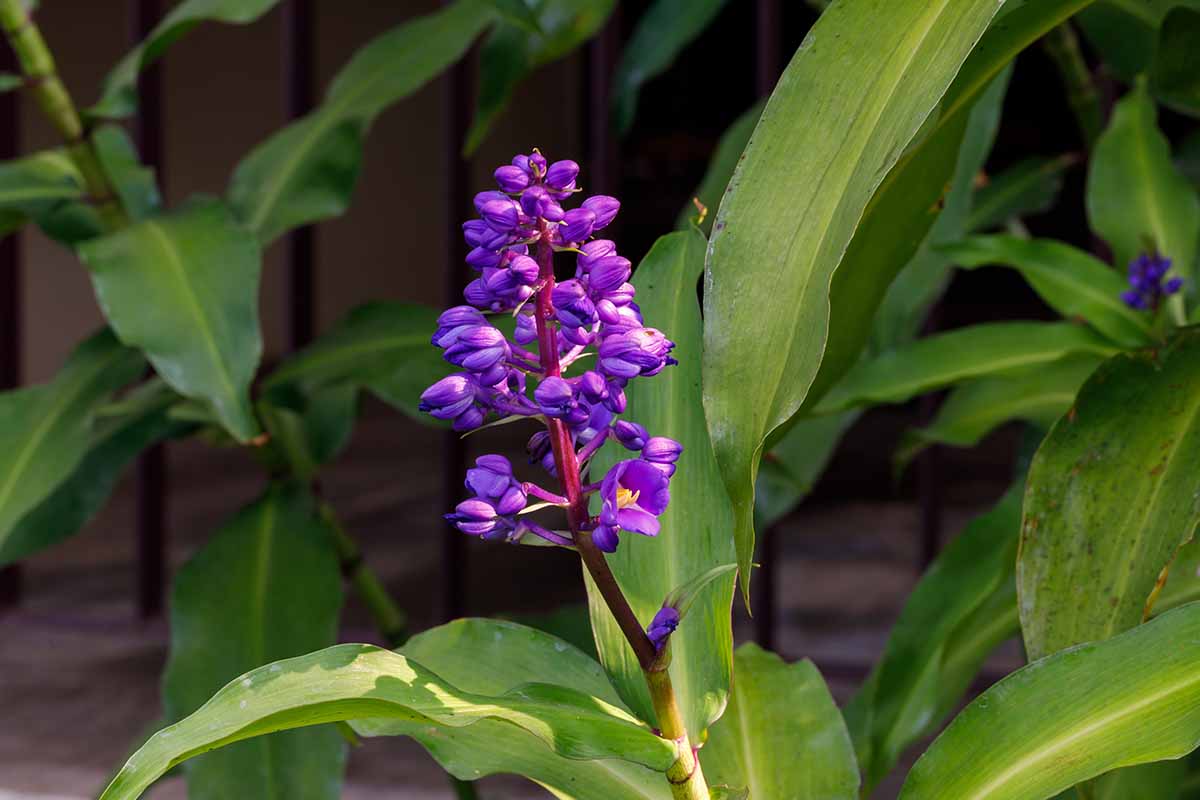
In fall or spring, prepare a well-draining growing medium, whether it’s soil somewhere in your garden or in a container.
Make sure the transplant site or your intended indoor location is situated in a spot where it will receive partial shade or indirect light.
Dig a hole that’s as deep as and slightly wider than the transplant’s root system. Lower the plant in, backfill the hole, and water in the transplant. Keep the medium around the transplant moist.
How to Grow
In some respects, blue ginger is tougher than it looks – it can handle humid conditions, brief periods of drought, and being root-bound.
But in other ways, D. thyrsiflora can be a bit namby-pamby.
Regardless, proper cultivation goes a long way in keeping this plant healthy and happy.
Climate and Exposure Needs
For year-round outdoor growth, make sure your garden is located in Zones 9 to 12.
Ensure partial shade exposure, protection from wind, and ample humidity – especially when the plant is in full bloom.
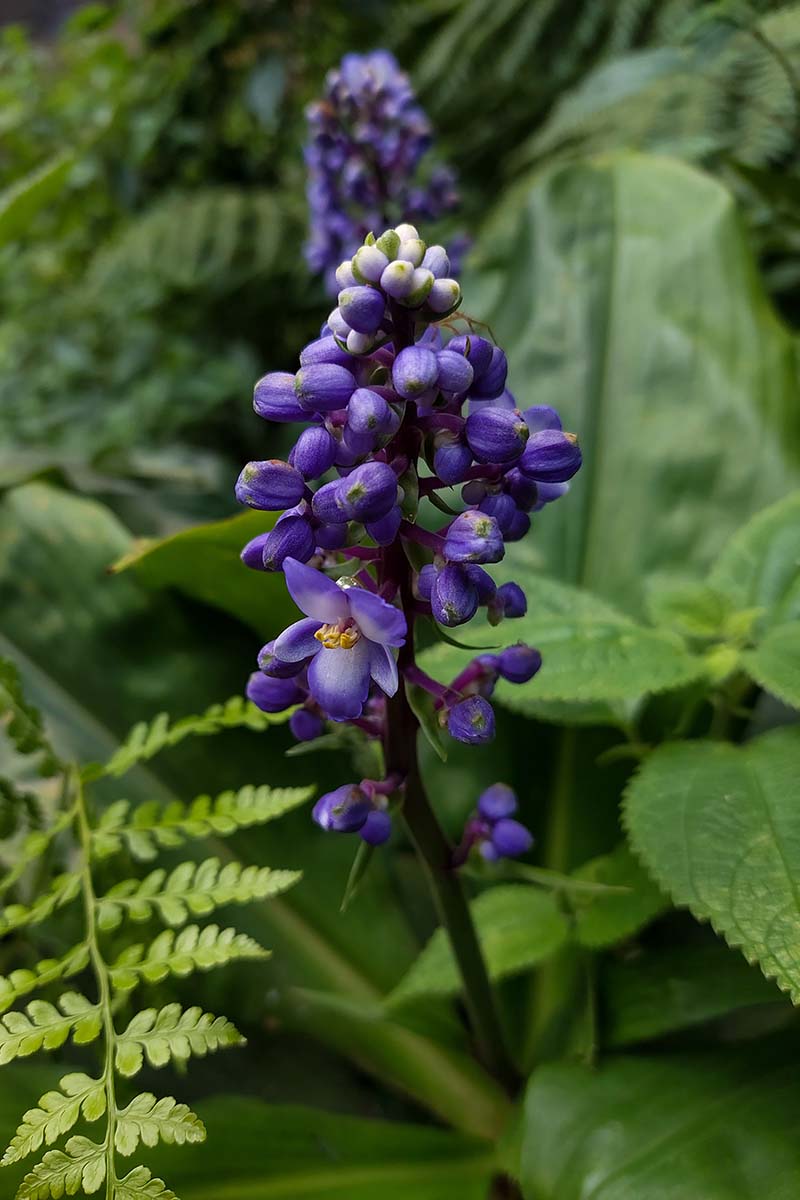
Blue ginger dislikes chills and is quite sensitive to frost, so bring plants inside if outdoor conditions at night ever dip below 55°F to avoid interrupting their blooming cycle at best, or killing them in the worst case scenario.
Any in-ground plantings can be mulched or protected with polypropylene cloth to reduce the risk of cold damage if the temperature takes a dive.
Indoor growth requires bright yet indirect light, a minimum temperature of 60°F, and plenty of humidity. The latter can be increased by grouping plants together or placing a humidifier nearby.
Growing Media Needs
An organic and well-draining potting or planting medium is essential.
The exact soil texture or soilless mixture composition isn’t as important as the end result, though – “there are many paths up the same mountain,” as the saying goes.

Blue ginger needs to be sitting in a media with a pH of 6.1 to 7.5, ideally.
For outdoor plantings, amending the soil with a couple inches of compost or well-rotted organic material each fall will provide fertility and a more workable soil tilth.
Water and Fertilizer Needs
Just like with dipping cookies in milk, “moist” is the goal with blue ginger watering.
Not “drenched” – that leads to cookie crumbling, and an unhealthy plant. To maintain soil moisture, add water whenever the surface of the media feels dry to the touch.
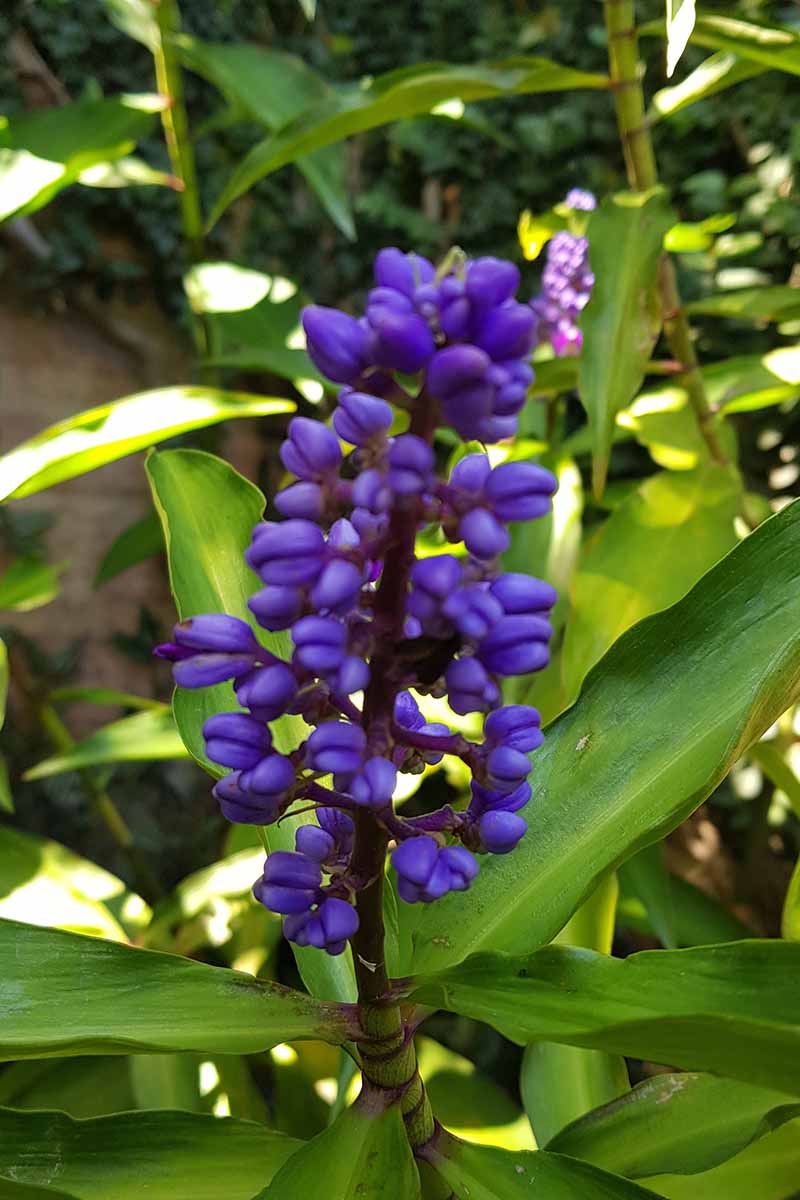
Remember that D. thyrsiflora can survive brief periods of drought. Don’t use this factoid as an excuse to slack on irrigation, but rather, as an “extra life” in case you forget.
Applying a balanced fertilizer on occasion will help prevent nutritional deficiency. “On occasion” means every four times you water throughout the growing season, tapering to once every six times during late autumn and winter.

If you’re looking for an appropriate fertilizer, Hydrohort offers quart-sized containers of liquid 15-15-15 NPK fertilizer on Amazon.
Growing Tips
- Provide partial shade outdoors or bright, indirect light indoors.
- Ensure that the growing media is well-draining.
- Keep the growing media moist.
Pruning and Maintenance
With sterilized tools, prune away any dead or dying leaves whenever you happen to notice them.
Once the flowers are spent, you can snip them off, or you may cut the stems down to the ground when plants have finished flowering to promote lush regrowth.

Adding a couple inches of mulch will do wonders for maintaining soil moisture and suppressing weeds. Organic wood chips and leaf litter are both solid options.
For container plantings, repotting should be done on an “as-absolutely-necessary” basis.
This plant can tolerate root bindage, but once said roots start poking out the drainage holes in the bottom of the container, you’ll want to repot.
Growing your blue ginger beyond its preferred hardiness range?
Don’t forget to bring your plantings inside before outdoor temperatures dip below 55°F! Container plants can be brought back outdoors once temps consistently stay above 55°F at night.
Where to Buy
If you’re trying to snag a few of these bad boys for your garden, your best bet is to check out garden centers and nurseries in your area with a decent selection of tropical plants.
Meetups with other plant geeks and frequenting plant-swap events are additional ways that you could end up with your very own D. thyrsiflora… and maybe even a few new friends, to boot!
Select online vendors may have blue ginger available for purchase as well.
A three-pack of two- to four-inch rhizomes is available from Amazon.
Looking for just a single rhizome to get started? Find it now at Walmart.
Managing Pests and Disease
Providing your blue ginger with tender loving care is only half of the battle. The other half? Keeping it free of pathogens and pests.
Insects
In the garden, cultivating beauty means watching out for the beasts… especially the creepy-crawly ones.
Because insects can also vector disease, managing them can have the fringe benefit of preventing infections!
Aphids
Typically green, translucent, and soft-bodied, aphids use their piercing-sucking mouthparts to extract the phloem from leaf tissues, which can often result in disease transmission.
While feeding, aphids also excrete honeydew, which can attract ants, interfere with photosynthesis, and result in the development of black sooty mold.
High-velocity sprays of water work to knock aphids off of plant surfaces, while applications of horticultural oil on infested tissues will snuff out these pests without harming the beneficial insects in your garden.
Monterey offers multi-functional horticultural oil in a variety of different volumes via Arbico Organics.
Additional tips for aphid control can be found in our guide.
Mealybugs
White and cottony in appearance, mealybugs clump together on leaf axils or roots, depending on the species.
Feeding in a fashion similar to aphids, mealybugs can cause the death of infested plant parts, and infestations may stunt overall growth.
The above tips for aphid control work for mealybug management, too.
Additionally, drenching the soil with pyrethrin targets the nervous system of any mealybugs present, resulting in paralysis and death.

If the latter interests you, eight-ounce containers of pyrethrin from Pyganic Gardening are available on Amazon.
Scale
Seen in the garden in both soft-bodied and armored forms, scale insects are round and small – and this is yet another pest that feeds with its piercing-sucking mouthparts.
When infestations are sufficiently large, the infested plant usually ends up weakened and stunted, not to mention covered with a bunch of unaesthetic bugs.
All of the pest control tips covered so far – blasts of water, applications of horticultural oil, and drenching the soil with pyrethrin – work as ways of controlling scale.
Disease
Using sterilized tools has already been mentioned a lot in this guide, but it’s hugely important for preventing disease. Clean soil and pathogen-free plantings are also key.
The most common culprit that we’ll cover here is often the result of gardener input, in the form of overwatering and a lack of good drainage.
Root Rot
Roots need air as well as water. You won’t hear them gasping for breath or anything, but they respire at the cellular level, just like you and I do.
In over-saturated soils, roots won’t receive the oxygen that they need.
When deprived for extended periods, the roots begin to turn necrotic, which negatively impacts shoot growth above the soil line as well. Eventually, this could culminate in the plant’s death.
Providing proper drainage is essential for preventing root rot. Dig up any afflicted plants and prune the damaged parts of their root systems, along with a proportionate amount of shoots.
Any specimens beyond saving should be thrown away, and containers should be sterilized before reuse.
Best Uses
The glorious flowers and foliage of blue ginger deserve to be shown off – display them proudly as specimen plantings in a location that supports visual emphasis somewhere in your garden.

The clump-forming tendency of D. thyrsiflora makes it ideal for grouping together in large colonies, which will in time happen naturally.
Plants situated close together will also be able to support each other and hold themselves more upright, rather than hanging slightly pendulously like they would on their own.
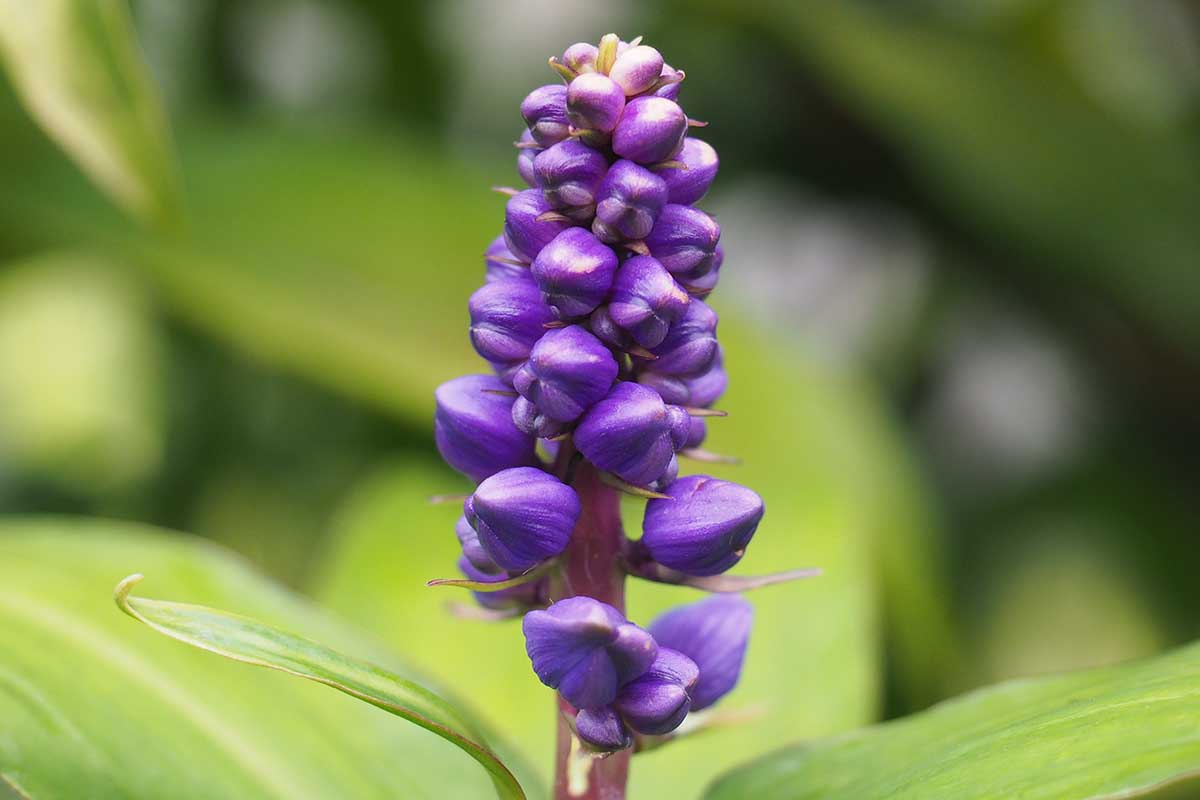
Indoors, these guys are attractive houseplants or greenhouse plantings.
If you’re into floral design, then harvesting blue ginger blooms at the peak of their aesthetics will leave you with awesome-looking arrangement materials!
Quick Reference Growing Guide
| Plant Type: | Herbaceous flowering evergreen perennial | Flower/Foliage Color: | Violet blue/deep green |
| Native to: | Brazil | Tolerance: | Brief drought, humidity, root bindage |
| Hardiness (USDA Zone): | 9-12 | Maintenance: | Moderate |
| Bloom Time: | Summer to fall | Water Needs: | Moderate |
| Exposure: | Part shade | Soil Type: | Fertile |
| Time to Maturity: | 3-6 years | Soil pH: | 6.1-7.5 |
| Planting Depth: | Depth of root system, 1-2 inches (rhizomes) | Soil Drainage: | Well-draining |
| Spacing: | 18-36 inches | Attracts: | Bees |
| Height: | 3-8 feet | Uses: | Grouping/massing, houseplant, specimen, cut arrangements |
| Spread: | 2-3 feet | Family: | Commelinaceae |
| Growth Rate: | Fast | Genus: | Dichorisandra |
| Common Pests and Diseases: | Aphids, mealybugs, scale; root rot | Species: | Thyrsiflora |
The Best Kind of Blue Funk
Outside the garden, my go-to remedy for feeling blue is therapy. Inside the garden, however, a blue mood can be dispelled with some well-placed D. thyrsiflora.
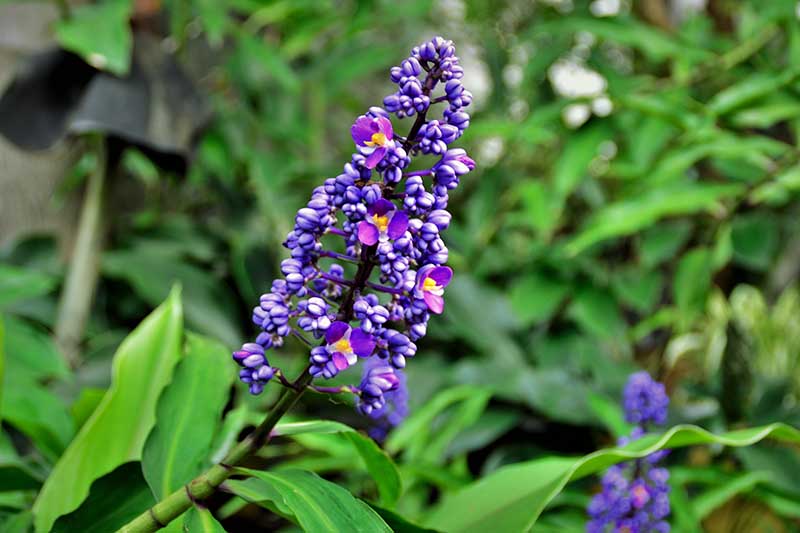
Even when you look beyond the flowers, the leaves are absolutely stunning… but regardless of which botanical element you consider the show-stopper, blue ginger makes for quite the tropical upgrade to your landscape.
Got questions or remarks to share? Put them in the comments section below!
Can’t get enough blue flowering plants? I bet you’ll really (indi)go for these guides:
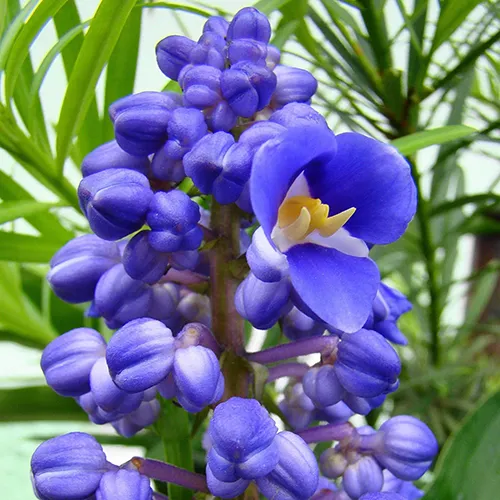
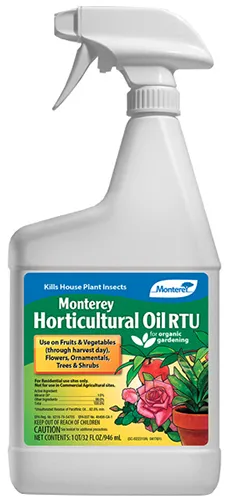

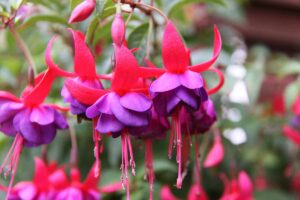

Healthy blue ginger plants but no flowers. What do they need?
How’s your fertilization? Or perhaps you just need to wait a bit longer — flowering usually takes at least three years.